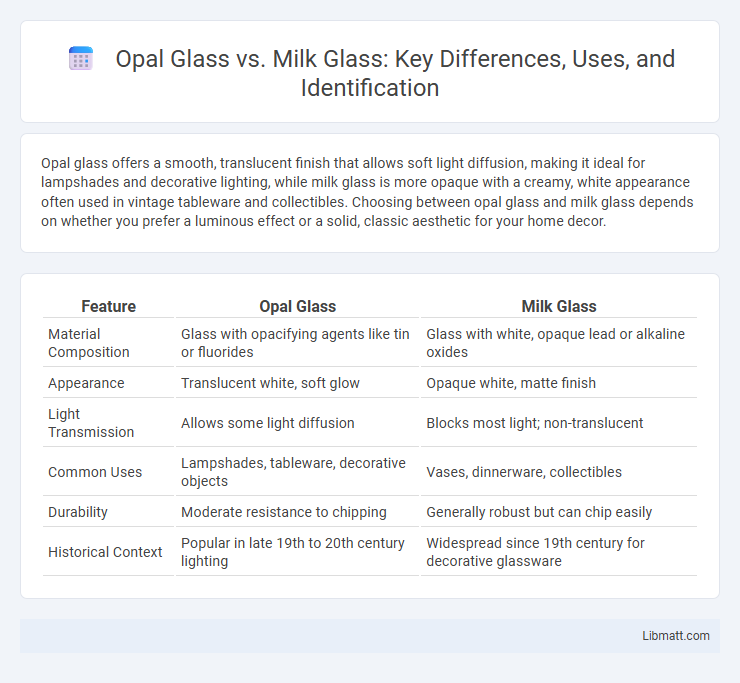Opal glass offers a smooth, translucent finish that allows soft light diffusion, making it ideal for lampshades and decorative lighting, while milk glass is more opaque with a creamy, white appearance often used in vintage tableware and collectibles. Choosing between opal glass and milk glass depends on whether you prefer a luminous effect or a solid, classic aesthetic for your home decor.
Table of Comparison
| Feature | Opal Glass | Milk Glass |
|---|---|---|
| Material Composition | Glass with opacifying agents like tin or fluorides | Glass with white, opaque lead or alkaline oxides |
| Appearance | Translucent white, soft glow | Opaque white, matte finish |
| Light Transmission | Allows some light diffusion | Blocks most light; non-translucent |
| Common Uses | Lampshades, tableware, decorative objects | Vases, dinnerware, collectibles |
| Durability | Moderate resistance to chipping | Generally robust but can chip easily |
| Historical Context | Popular in late 19th to 20th century lighting | Widespread since 19th century for decorative glassware |
Introduction to Opal Glass and Milk Glass
Opal glass is a type of opaque or translucent glass made by adding specific minerals such as tin dioxide or bone ash to create a smooth, milky appearance. Milk glass, a subset of opal glass, is characterized by its solid, white, and non-translucent finish often used in decorative pieces and tableware. Both types share similar chemical compositions but differ primarily in opacity and texture, influencing their aesthetic and functional applications.
Historical Background of Opal Glass and Milk Glass
Opal glass originated in the 19th century as a type of opaque or translucent glass used for decorative and functional objects, gaining popularity in Europe for its milky, lustrous appearance. Milk glass, dating back to the 16th century in Venice, was initially created to imitate porcelain and became widely produced in both Europe and America during the 19th and early 20th centuries for tableware and ornamental items. Both types of glass share historical significance in decorative arts, representing distinct techniques and aesthetic trends in glassmaking.
Visual Differences: Opal Glass vs Milk Glass
Opal glass features a translucent, milky-white appearance that allows soft light transmission, creating a glowing effect, while milk glass is more opaque with a solid, creamy white finish that blocks light. Opal glass often exhibits a smoother, more delicate surface compared to the denser, matte texture of milk glass. These visual differences make opal glass ideal for decorative lighting, whereas milk glass is preferred for vintage-style tableware and collectibles.
Composition and Manufacturing Process
Opal glass is made by adding fluorides and oxides such as calcium fluoride and zirconium oxide to molten glass, resulting in a translucent, milky appearance through controlled crystallization. Milk glass is produced by incorporating tin oxide or bone ash into the molten glass mixture, creating an opaque white finish through uniform dispersion of particles. Both materials undergo precise temperature regulation during kiln firing to develop their characteristic textures and light-diffusing properties.
Durability and Strength Comparison
Opal glass typically offers higher durability and resistance to chipping compared to milk glass due to its denser composition and firmer molecular structure. Milk glass, while aesthetically pleasing with its opaque, milky appearance, is generally more prone to cracking and breakage under stress. The enhanced strength of opal glass makes it more suitable for everyday use in functional items such as dinnerware and lighting fixtures.
Uses and Applications in Modern Design
Opal glass is widely utilized in modern lighting fixtures for its translucent quality that diffuses light evenly, creating a soft, ambient glow ideal for residential and commercial spaces. Milk glass, known for its opaque, creamy white appearance, is commonly applied in decorative objects, tableware, and vintage-inspired home accessories to add a nostalgic, elegant touch. Both materials are favored in contemporary interior design for blending functional durability with aesthetic appeal, enhancing both minimalist and eclectic styles.
Collectibility and Value in the Antique Market
Opal glass and milk glass both hold unique positions in the antique market, with opal glass often prized for its translucence and delicate sheen, making certain pieces highly collectible and valuable. Milk glass, characterized by its opaque white appearance, is widely sought after for vintage tableware and decorative items, with rarity and artist attribution significantly impacting prices. Understanding the subtle differences in texture, origin, and craftsmanship can help you assess the collectibility and value of these glass types for investment or personal collection.
Maintenance and Care Tips
Opal glass requires gentle cleaning with mild soap and a soft cloth to avoid scratches and preserve its translucent quality, while milk glass demands careful handling to prevent chipping and discoloration due to its opaque nature. Avoid abrasive cleaners and sudden temperature changes for both types to maintain their appearance and structural integrity. Storing these glass pieces away from direct sunlight helps prevent fading and prolongs their aesthetic appeal.
Environmental Impact and Sustainability
Opal glass typically has a lower environmental impact due to its longer durability and recyclability compared to milk glass, which often contains additives that complicate recycling processes. Choosing opal glass can contribute to sustainability by reducing waste and promoting circular economy practices within glass manufacturing. Your commitment to selecting eco-friendly materials supports efforts to minimize ecological footprints in everyday products.
Choosing Between Opal Glass and Milk Glass
Opal glass offers a translucent, milky appearance with excellent light diffusion, making it ideal for lighting fixtures and decorative items that require a soft glow. Milk glass features an opaque, glossy finish with a vintage charm, commonly used for tableware and collectible pieces that emphasize classic aesthetics. Choosing between opal glass and milk glass depends on desired transparency, application, and stylistic preference, prioritizing opal for light diffusion and milk glass for solid, decorative appeal.
opal glass vs milk glass Infographic

 libmatt.com
libmatt.com